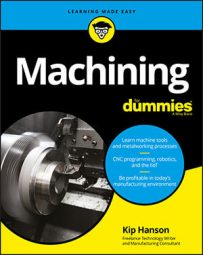- The cutting tools used on CNC lathes are generally "stationary," meaning the tool holds still while the workpiece rotates beneath it. Machining centers, on the other hand, use cutting tools that are held in a rotating spindle.
- The centuries-old distinction between stationary and rotary tools and the machine tools they are used on is beginning to blur as multitasking and turn-mill centers grow in popularity.
- High-speed steel (HSS) was the first big advancement in cutting-tool technology, but has largely been replaced by tool bits made of tungsten carbide and other super-hard materials. HSS is still widely used, however, for drill bits, saw blades, and other cutting tools where a tough, wear-resistant, and low-cost metal is needed.
- One of the super-hard materials just mentioned is polycrystalline cubic boron nitride (PCBN), which is able to efficiently machine hardened steel, and in some cases, has eliminated secondary grinding operations.
- Most types of cutting tools, including drills, end mills, turning tools, and boring bars, are available in a solid, single-piece construction (the most expensive but also high-performance option) or with indexable "inserts" with multiple cutting edges, designed to be used up and recycled.
- Holemaking is the most common of all metalworking operations. Drilling, reaming, boring, trepanning—these are just a few of the dozen or so ways to either make holes or to improve their accuracy and surface finish.
- The majority of cutting tools today are coated with hard, lubricious materials applied in special vacuum chambers. Some examples include titanium aluminum nitride (TiAlN), zirconium nitride (ZrN), titanium carbon nitride (TiCN), and many others. All improve wear resistance and tool life.
- With the thousands of available cutting-tool styles, geometries, coatings, and brands, it's important to develop a sound policy on their use, testing, and procurement, else "tool crib bloat" is sure to occur.

